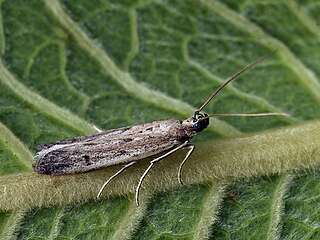
Homoeosoma nebulella, the Eurasian sunflower moth, is a moth of the family Pyralidae. It is found in Europe, Russia, Anatolia, the Middle East and West Africa. The wingspan is 20–27 mm.

Homoeosoma nimbella is a moth of the family Pyralidae. It is found in Europe.
Sunflower moths may be three species of moths, whose larvae are pests of sunflowers:

Homoeosoma is a genus of moths of the family Pyralidae.

Homoeosoma inustella is a species of snout moth in the genus Homoeosoma. It was described by Ragonot in 1884. It is found in Spain, France, Italy, Switzerland, Austria, the Czech Republic, Slovakia, Hungary, Romania, Bulgaria, the Republic of Macedonia, Ukraine, Belarus and Russia.
Homoeosoma masaiensis is a species of snout moth in the genus Homoeosoma. It was described by Boris Balinsky in 1991 and is known from South Africa.
Homoeosoma stenopis is a species of snout moth in the genus Homoeosoma. It was described by Alfred Jefferis Turner in 1904. It is found in Australia.
Homoeosoma achroeella is a species of snout moth in the genus Homoeosoma. It was described by Émile Louis Ragonot in 1887, and is known from Kazakhstan and Turkey.
Homoeosoma albescentellum is a species of snout moth in the genus Homoeosoma. It was described by Émile Louis Ragonot in 1887. It is found in western North America, including California, Nevada and Washington.

Homoeosoma deceptorium is a species of snout moth in the genus Homoeosoma. It was described by Carl Heinrich in 1956. It is found in much of eastern North America, including Florida, Georgia, Illinois, Indiana, Maryland, North Carolina, Ohio, Oklahoma, Ontario and West Virginia.
Homoeosoma inornatellum is a species of snout moth in the genus Homoeosoma. It was described by George Duryea Hulst in 1900. It is found in North America, including New Jersey and Pennsylvania.
Homoeosoma striatellum is a species of snout moth in the genus Homoeosoma. It was described by Harrison Gray Dyar Jr. in 1905. It is found in North America, including Arizona, California and Nevada.
Homoeosoma asylonnastes is a species of snout moth in the genus Homoeosoma. It was described by R. L. Goodson and Herbert H. Neunzig in 1993. It is found in North America, including Tennessee and West Virginia.
Homoeosoma emandator is a species of snout moth in the genus Homoeosoma. It was described by Carl Heinrich in 1956. It is found in North America.
Homoeosoma uncanale is a species of snout moth in the genus Homoeosoma. It was described by George Duryea Hulst in 1886. It is found in North America, including Arizona and California.
Homoeosoma ardaloniphas is a species of snout moth in the genus Homoeosoma. It was described by R. L. Goodson and Herbert H. Neunzig in 1993. It is found in North America, including North Dakota.
Homoeosoma pedionnastes is a species of snout moth in the genus Homoeosoma. It was described by R. L. Goodson and Herbert H. Neunzig in 1993. It is found in North America, including Florida and Maryland.
Homoeosoma ammonastes is a species of snout moth in the genus Homoeosoma. It was described by R. L. Goodson and Herbert H. Neunzig in 1993. It is found in North America, including North Carolina.
Homoeosoma eremophasma is a species of snout moth in the genus Homoeosoma. It was described by R. L. Goodson and Herbert H. Neunzig in 1993. It is found in North America, including Arizona.


